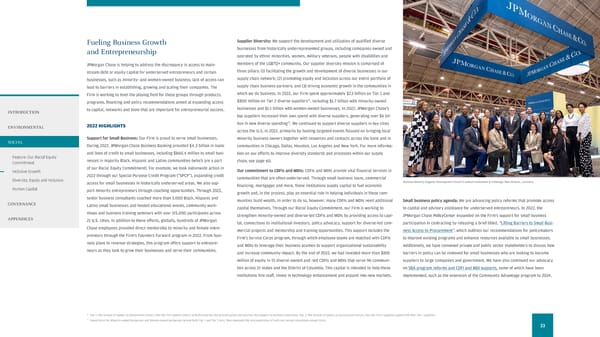Fueling Business Growth Supplier Diversity: We support the development and utilization of qualifed diverse and Entrepreneurship businesses from historically underrepresented groups, including companies owned and operated by ethnic minorities, women, military veterans, people with disabilities and JPMorgan Chase is helping to address the discrepancy in access to main- members of the LGBTQ+ community. Our supplier diversity mission is comprised of stream debt or equity capital for underserved entrepreneurs and certain three pillars: (1) facilitating the growth and development of diverse businesses in our businesses, such as minority- and women-owned business; lack of access can supply chain network; (2) promoting equity and inclusion across our entire portfolio of lead to barriers in establishing, growing and scaling their companies. The supply chain business partners; and (3) driving economic growth in the communities in Firm is working to level the playing feld for these groups through products, which we do business. In 2022, our Firm spent approximately $2.1 billion on Tier 1 and $800 million on Tier 2 diverse suppliers22 programs, fnancing and policy recommendations aimed at expanding access , including $1.7 billion with minority-owned to capital, networks and tools that are important for entrepreneurial success. businesses and $1.1 billion with women-owned businesses. In 2022, JPMorgan Chase’s INTRODUCTION top suppliers increased their own spend with diverse suppliers, generating over $6 bil- lion in new diverse spending23 2022 HIGHLIGHTS . We continued to support diverse suppliers in key cities ENVIRONMENTAL across the U.S. in 2022, primarily by hosting targeted events focused on bringing local Support for Small Business: Our Firm is proud to serve small businesses. minority business owners together with resources and contacts across the bank and in SOCIAL During 2022, JPMorgan Chase Business Banking provided $4.3 billion in loans communities in Chicago, Dallas, Houston, Los Angeles and New York. For more informa- and lines of credit to small businesses, including $860.4 million to small busi- tion on our eforts to improve diversity standards and processes within our supply Feature: Our Racial Equity nesses in majority Black, Hispanic and Latino communities (which a re a part Commitment chain, see page 60. Inclusive Growth of our Racial Equity Commitment). For example, we took nationwide action in Our commitment to CDFIs and MDIs: CDFIs and MDIs provide vital fnancial services in 2022 through our Special Purpose Credit Program (“SPCP”), expanding credit communities that are often underserved. Through small business loans, commercial Diversity, Equity and Inclusion access for small businesses in historically underserved areas. We also sup- National M inority Supplier Development Council’s Annual Conference & Exchange , New Orleans, Louisiana. Human Capital fnancing, mortgages and more, these institutions supply capital to fuel economic port minority entrepreneurs through coaching opportunities. Through 2022, growth and, in the process, play an essential role in helping individuals in these com- senior business consultants coached more than 3,000 Black, Hispanic and munities build wealth. In order to do so, however, many CDFIs and MDIs need additional Small business policy agenda: We are advancing policy reforms that promote access GOVERNANCE Latino small businesses and hosted educational events, community work- capital themselves. Through our Racial Equity Commitment, our Firm is working to to capital and advisory assistance for underserved entrepreneurs. In 2022, the shops and business training seminars with over 115,000 participants across strengthen minority-owned and diverse-led CDFIs and MDIs by providing access to capi- JPMorgan Chase PolicyCenter expanded on the Firm’s support for small business APPENDICES 21 U.S. cities. In addition to these eforts, globally, hundreds of JPMorgan tal, connections to institutional investors, policy advocacy, support for diverse-led com- participation in contracting by releasing a brief titled, “Lifting Barriers to Small Busi- Chase employees provided direct mentorship to minority and female entre- mercial projects and mentorship and training opportunities. This support includes the ness Access to Procurement”, which outlines our recommendations for policymakers preneurs through the Firm’s Founders Forward program in 2022. From busi- Firm’s Service Corps program, through which employee teams are matched with CDFIs to improve existing programs and enhance resources available to small businesses. ness plans to revenue strategies, this program ofers support to entrepre- and MDIs to leverage their business acumen to support organizational sustainability Additionally, we have convened private and public sector stakeholders to discuss how neurs as they look to grow their businesses and serve their communities. and increase community impact. B y the end of 2022, we had invested more than $100 barriers in policy can be removed for small businesses who are looking to become million of equity in 15 diverse-owned and -led CDFIs and MDIs that serve 96 communi- suppliers to large companies and government. We have also continued our advocacy ties across 21 states and the District of Columbia. This capital is intended to help these on SBA program reforms and CDFI and MDI supports, some of which have been institutions hire staf, invest in technology enhancement and expand into new markets. implemented, such as the extension of the Community Advantage program to 2024. 22 Tier 1: The amount of spend, or procurement dollars, that the Firm spends directly with third parties that provide goods and services that support its business operations. Tier 2: The amount of spend, or procurement dollars, that the Firm's suppliers spend with their Tier 1 suppliers. 23 Spend totals for Minority-owned businesses and Women-owned businesses include both Tier 1 and Tier 2 data. They represent the total population of each and are not considered unique totals. 33
 2022 Environmental Social Governance Report Page 34 Page 36
2022 Environmental Social Governance Report Page 34 Page 36